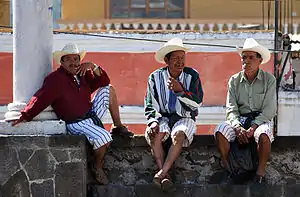Tzʼutujil people
The Tzʼutujil (Tzutujil, Tzutuhil, Sutujil) are a Native American people, one of the 21 Maya ethnic groups that dwell in Guatemala. Together with the Xinca, Garífunas (Black Caribs) and the Ladinos, they make up the 24 ethnic groups in this relatively small country. Approximately 100,000 Tzʼutujil live in the area around Lake Atitlán. Their pre-Columbian capital, near Santiago Atitlán, was Chuitinamit. In pre-Columbian times, the Tzʼutujil nation was a part of the ancient Maya civilization.
| Total population | |
|---|---|
| 106,012[1] | |
| Regions with significant populations | |
| Languages | |
| Tzʼutujil | |
| Related ethnic groups | |
| Kʼicheʼ, Kaqchikel |

The Tzʼutujil are noted for their continuing adherence to traditional cultural and religious practices. Some also practice Evangelical Protestantism or Roman Catholicism. They speak the Tzʼutujil language, a member of the Mayan language family.
History and demographics
The Tzʼutujil date from the post-classic period (circa 900-1500) of the Maya civilization, inhabiting the southern watershed of Lake Atitlán, in what is now defined as the Solola region of the Guatemalan highlands.
Today they dwell primarily in the towns of San Juan La Laguna, San Pablo La Laguna, San Marcos La Laguna, San Pedro La Laguna, Santiago Atitlán, Panabaj, Tzanchaj (believed to have been the inspiration, because of its similar sound, for the name "Santiago"), with fewer in San Lucas Tolimán. This people used to inhabit a much wider region. In 1523 the Spanish conquistador Pedro de Alvarado, with the help of the Kaqchikel Maya, defeated them in a battle close to the town of Panajachel. At that time they lost a portion of their lands, and the control of the lake.
In 2005, several hundred Tzʼutujil died in the mudslides caused by Hurricane Stan. Rescuers recovered 160 bodies from Panabaj and Tzanchaj, while a total of 250 persons remained missing from both towns.
Economics
Although tourism is now an increasing source of income in the region, many Tzʼutujil still practice traditional methods of farming of the two main crops in the region, coffee and maize (corn). Tourism has provided a market for the talented artists and weavers, who seek recognition for their creativity and unique works.
San Juan is one of three Tzʼutujil communities where artists have adapted the international genre of Arte Naif to express the cultural traditions, beliefs, ceremonies, and daily activities of their indigenous culture. This form of art and some of its most accomplished Tzʼutjil practitioners have been recognized in the definitive UNESCO-sponsored book on the subject, Arte Naif: Contemporary Guatemalan Mayan Painting (1998). The weavers of San Juan are among the few indigenous artisans who make their own dyes for the yarns they use; they produce the dyes largely from locally grown plants.
See also
- Martín Prechtel, author who writes of his experiences with the Tzutujil people.
- Maya mythology
- Maya calendar
- Ixchel
- Blessed Father Stanley Rother, a priest from the Archdiocese of Oklahoma City, who died in 1981, martyred in the mission area. He had translated the Bible into Tzʼutujil and used his family knowledge of farming to aid the people, who grew to respect him. (He was formally recognized in September 2017 by Pope Francis with beatification.)[2]
References
- "Resultados Censo 2018" (PDF). Instituto Nacional de Estadistica Guatemala. Retrieved 9 May 2020.
- http://stanleyrother.org/about/
External links
- Website of Santiago Atitlán
- Chuitinamit History and description
- Guatemala indigenous people Photo Gallery
- Anthropologist's Blog about learning Tzʼutujil in San Pedro La Laguna
- Vocabulary and Basic Phrases between Tzʼutujil, Spanish, and English
- Video featuring Tzʼutujil woman telling stories about local history
